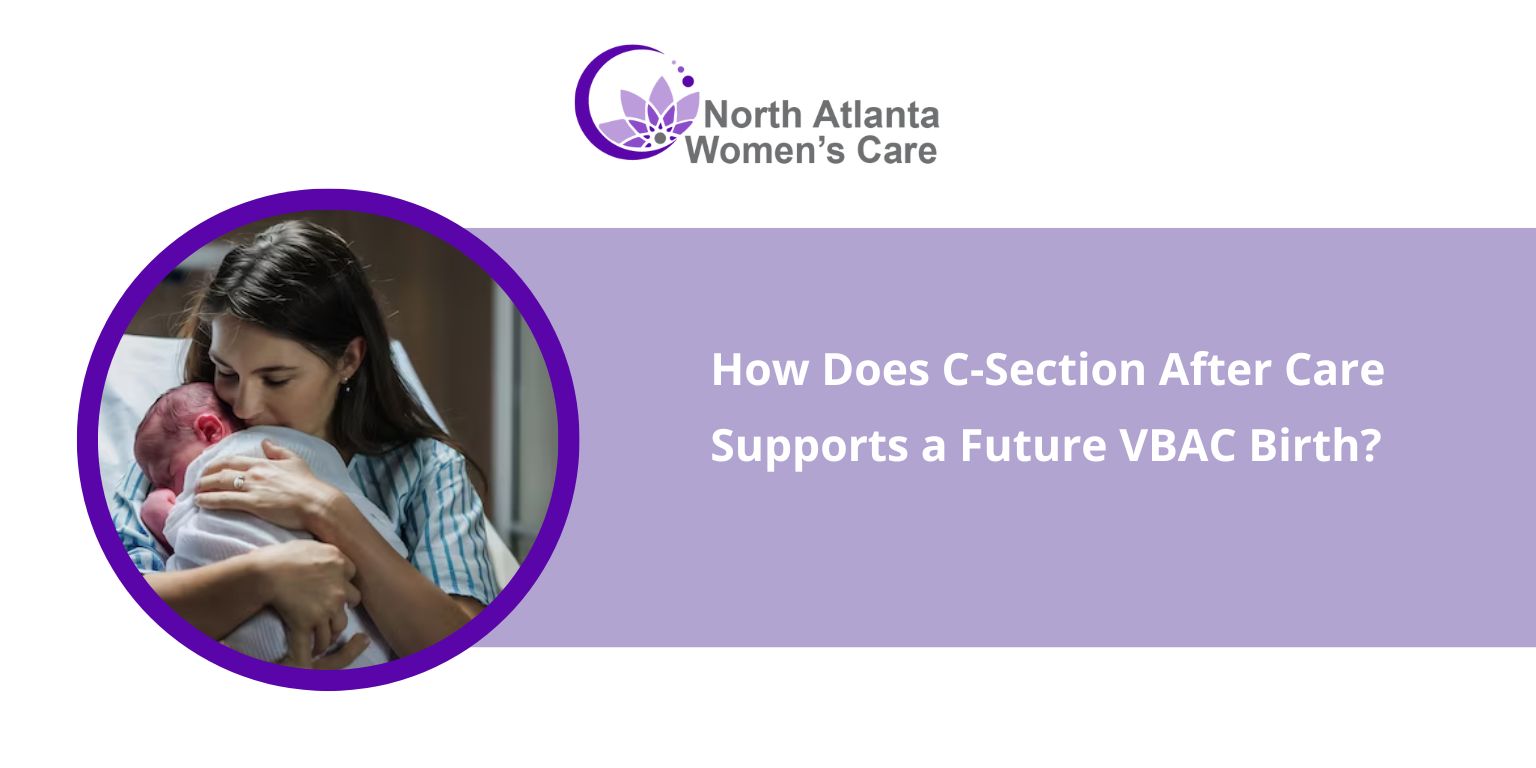How Does C-Section After Care Supports a Future VBAC Birth?

A Cesarean delivery, or C-section, is a surgical procedure used to deliver a baby through incisions in the mother’s abdomen and uterus. At the same time, it’s often a life-saving intervention, many women who’ve had one C-section wonder whether they can experience a natural birth in the future. The answer is often yes, through what’s known as a VBAC (Vaginal Birth After Cesarean).
VBAC offers mothers the chance to give birth vaginally after a previous C-section. It’s a safe and successful option for many women. However, achieving this outcome requires more than just time between pregnancies, it depends significantly on how well you recover after your first C-section. Proper after C-section care strengthens your body, supports uterine healing, and prepares you physically and emotionally for a future VBAC birth.
Let’s explore how mindful recovery, physical health, and emotional readiness after a C-section can improve your chances of a safe and successful VBAC delivery.
Understanding VBAC Birth
VBAC, or Vaginal Birth After Cesarean, is a birthing option where a woman who has previously had a C-section gives birth vaginally in a later pregnancy. It has become increasingly preferred among mothers who wish to avoid repeat surgeries, experience natural childbirth, and recover faster postpartum.
Common Misconceptions About VBAC
Many women believe VBAC is unsafe or is always discouraged by doctors. In reality, the majority of women with a low-transverse (horizontal) uterine incision, the most common type, are eligible candidates.
Modern medical practices and continuous fetal monitoring have made VBAC safer than ever. Complications like uterine rupture occur in less than 1% of VBAC attempts, proving that with proper medical support and after C-section care, it’s a viable and safe choice.
Factors That Influence VBAC Eligibility:
- Type and location of the previous uterine incision.
- Time gap between pregnancies (ideally between 18 months and less than 5 years).
- Overall health and recovery post-C-section.
- The reason for the previous Cesarean.
- The hospital’s VBAC support facilities.
Understanding these factors helps you and your OB-GYN create a birth plan that prioritizes both safety and success.
Importance of After C-Section Care
Proper after C-section care is the foundation for future vaginal delivery. The healing process involves both internal and external recovery, as your body works to repair muscle layers, tissues, and uterine strength.
Key Aspects of Recovery:
- Incision Healing: Keeping the surgical site clean, avoiding heavy lifting, and following your doctor’s wound care instructions prevent infection and scarring.
- Internal Healing: It takes several months for the uterus and surrounding tissues to regain full strength. Rushing back into physical strain can delay this process.
- Balanced Diet and Hydration: Nutrients like protein, iron, and vitamin C accelerate tissue repair and build uterine resilience.
- Gentle Physical Activity: Light walking after the first few weeks helps prevent blood clots, improves circulation, and supports long-term healing.
An intense recovery phase ensures that by the time you plan your subsequent pregnancy, your body is ready to support a VBAC birth after C-section safely.
Physical Recovery and Preparation for VBAC
Your body needs strength, flexibility, and endurance for a successful vaginal birth. Here are practical steps to prepare physically for a future VBAC:
- Gradual Exercise
Start with light movement once cleared by your doctor. As months progress, include pelvic floor exercises, core strengthening, and low-impact workouts. These improve muscle tone and reduce the risk of complications during labor. - Maintain a Healthy Weight
A balanced BMI reduces the risk of gestational diabetes and high blood pressure, two factors that may limit eligibility for VBAC. Choose whole foods, lean proteins, and fibre-rich meals to stay fit. - Prevent Adhesions and Uterine Weakness
Post-surgical adhesions (scar tissue inside the abdomen) can impact uterine flexibility. Gentle stretching, staying active, and guided physical therapy can help minimize these adhesions and improve mobility. - Seek Physical Therapy
Specialized postpartum physical therapy enhances core strength, pelvic alignment, and posture, all of which play a vital role in achieving an easier VBAC labor.
Emotional & Mental Readiness for VBAC
Recovering emotionally after a C-section is just as necessary as physical healing. Many mothers experience feelings of disappointment or anxiety about childbirth after their first delivery.
To prepare mentally for a VBAC:
- Acknowledge and process past experiences. Every birth story is unique, and it’s okay to feel a mix of emotions.
- Join VBAC preparation groups or online communities to hear positive stories and get practical tips.
- Consider counseling or childbirth education classes to address fears and build confidence.
- Discuss your concerns openly with your healthcare provider.
When you feel emotionally ready and supported, your body responds better during pregnancy and labor, increasing the likelihood of a successful VBAC.
Working with a VBAC-Supportive Doctor
Finding a VBAC doctor near me who supports your birth goals is crucial. Not all healthcare providers or hospitals are VBAC-friendly, so ask specific questions early in your planning.
What to Look For:
- A provider experienced in monitoring VBAC deliveries.
- Hospitals are equipped with emergency facilities, just in case.
- Doctors who communicate openly about risks and benefits.
Key Questions to Ask Your OB-GYN:
- Am I a good candidate for a VBAC birth?
- How long should I wait after my C-section before trying again?
- What are the success rates at your facility?
- What monitoring or emergency measures are in place?
Building trust with a supportive doctor ensures you make informed decisions every step of the way.
Healthy Pregnancy Practices Before Attempting VBAC
Before attempting a VBAC, focus on overall pregnancy health to support both mother and baby.
Recommended Practices:
- Eat a balanced diet rich in calcium, protein, folate, and iron.
- Take prenatal vitamins as advised.
- Stay active with safe exercises like prenatal yoga and walking.
- Avoid high-risk behaviors such as smoking or alcohol consumption.
- Attend regular prenatal appointments for ultrasound and uterine monitoring.
A healthy pregnancy strengthens your body and improves your chances of a smooth, safe vaginal birth.
When VBAC Might Not Be Recommended?
While many women can safely have a VBAC, there are situations where doctors may advise against it for safety reasons, such as:
- Multiple prior C-sections.
- A vertical or “classical” uterine incision.
- Uterine rupture or extensive scarring.
- Medical conditions like placenta previa or fibroids.
In such cases, your healthcare provider will discuss alternative birth options, ensuring that both your safety and your baby’s well-being remain the top priority.
A Confident VBAC Journey with North Atlanta Women’s Care
Your recovery after a C-section is more than just healing, it’s preparation for your next birth journey. By focusing on rest, balanced nutrition, emotional well-being, and regular medical care, you can improve your chances of a smooth and successful VBAC.
At North Atlanta Women’s Care, our team believes in empowering every woman through personalized guidance, compassionate care, and ongoing support. We’ll help you listen to your body, rebuild your strength, and move forward confidently toward the birth experience you desire.
If you’re thinking about a VBAC, contact us today to schedule your consultation and begin planning your subsequent healthy and fulfilling pregnancy.
Frequently Asked Questions (FAQs)
1. How do I know if I’m a good candidate for VBAC?
You’re likely a candidate if your previous C-section involved a low-transverse incision, your health is stable, and enough time has passed between pregnancies.
2. Can diet and nutrition affect VBAC success?
Yes. A nutrient-rich diet supports uterine health, energy, and hormonal balance, all of which are essential for labor and recovery.
3. How soon after a C-section can I try for a VBAC?
Experts recommend waiting between 18 months and less than 5 years to allow your uterus to heal fully.
4. Can scar tissue from a previous C-section impact VBAC success?
Excessive scar tissue or adhesions can sometimes affect flexibility, but physical therapy and gradual recovery can help minimize the impact.
5. Is weight gain a symptom of both PCOS and PCOD?
Weight gain is a common symptom in PCOS, primarily due to insulin resistance. However, it can also occur in PCOD, although it is usually less pronounced.
6. Are there natural ways to boost VBAC success?
Yes, staying active, maintaining a healthy weight, managing stress, and choosing a VBAC-supportive doctor all increase your chances of a successful outcome.
Be the first to post a comment


Leave a Reply Cancel reply